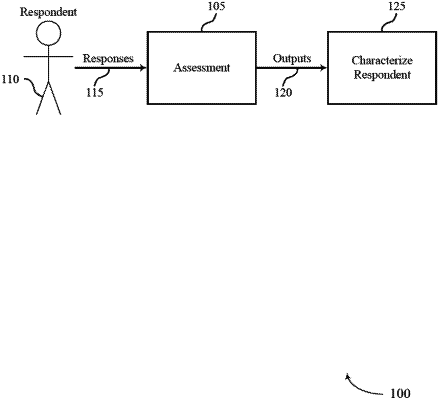| CPC G09B 7/02 (2013.01) [G06F 18/24155 (2023.01); G06N 7/01 (2023.01); G09B 7/00 (2013.01); G09B 7/04 (2013.01)] | 20 Claims |

|
1. A system for diagnostic assessment, comprising:
a diagnostic assessment component comprising:
a response manager configured to:
receive responses generated by respondents to items configured to classify at least one ability of the respondents; and
identify outputs of the items based on the responses generated by the respondents;
a mapping manager configured to:
map the items to a plurality of attributes associated with the respondents; and
apply a relationship matrix comprising objects that define relationships between the items and the attributes, wherein the objects are polytomous;
the mapping manager configured to identify a plurality of attribute profiles representing what attributes are possessed by the respondents, each attribute profile comprising a pattern of descriptive statistics indicating a permutation of possessed attributes;
an item parameter manager configured to:
identify one or more item parameters for each item based at least in part on the mapping of the items to the plurality of attributes, wherein a set of item parameters of the one or more item parameters associated with a first item is subject to a set of linear monotonicity constraints such that the set of item parameters and a first attribute profile of the plurality of attribute profiles associated with the first item is greater than zero, wherein the item parameters comprise a first multi-way item parameter, and wherein two or more attributes are associated with the first multi-way item parameter; and
tune the item parameters using machine learning based on the outputs, past diagnostic assessments, past item parameters, and past outputs, wherein tuning the item parameters comprises:
retrieving the outputs, the past diagnostic assessments, the past item parameters, and the past outputs from a database; and
storing updated item parameters in the database after tuning the item parameters;
a probability manager configured to:
determine a plurality of probabilities for each item based at least in part on identifying the one or more item parameters, each probability indicating a likelihood of a respective response to a respective item conditional on a respective attribute profile of a respective respondent; and
apply the plurality of probabilities to a standard normal cumulative distribution function;
a classification manager configured to classify the respondents with attribute profiles based at least in part on the responses received for the items and determining the plurality of probabilities for each item, wherein classifying the respondents with the attribute profiles is based at least in part on applying the plurality of probabilities to the standard normal cumulative distribution function; and
a vector manager configured to:
generate vector values by applying a vector-valued function to the attribute profiles and the objects of the relationship matrix; and
combine the vector values with the item parameters according to the function:
λiTh(qi,αr)=λi,0+Σa=1Aλi,1(a)(qiaαra)+Σa=1A−1Σb=a+1Aλi,2,(a,b)(qiaαra)(qibαrb),
where λ refers to the item parameters, h(qi, αr) refers to the vector-valued function, q refers to the relationship matrix, i refers to the items, α refers to the attribute profiles, r refers to the respondents, and a refers to the attributes; and
a processor in electronic communication with and configured to execute the diagnostic assessment component.
|